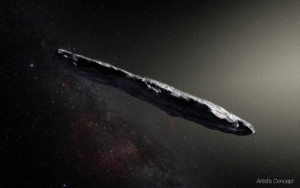
The discovery of ‘Oumuamua (1I/2019/U1) represented our first detection of a solar system object with an origin that was definitely outside of our solar system. Its name comes from Hawaiian meaning “first messenger from afar” yet deciphering its message has proved difficult and controversial. ‘Oumuamua was discovered by the Pan-STARRS telescope at the Haleakala Observatory in Hawaii on October 19, 2017, when it had already made its closest approach to the Earth on a hyperbolic orbit that would carry it back into the interstellar medium from which it came. Although currently classified as an interstellar comet, it has characteristics completely unlike any known comet. Its unusual shape, lack of a coma, and the fact that it exhibited non-gravitational acceleration has made its classification a complex problem. This talk will cover what is known about ‘Oumuamua and various proposals for its origin, including the suggestion that it is a product of alien technology.
Dr. Michael E. Summers
Sunday, June 13, 2021
7:30 PM to 9:00 PM EST
Online event
meet.google.com/osh-bcyd-gti
Monthly Meeting – Public Invited
Bio:
Dr. Michael E. Summers is Professor of Planetary Sciences and Astronomy at George Mason University. He has an undergraduate B.S. from Murray State University in Physics, Mathematics, and Russian, and a Ph.D. in Planetary Science from the California Institute of Technology.
His research focuses on the structure and evolution of planetary atmospheres. His research has concerned that of the atmospheres of Earth, Mars, Io, Titan, Triton, Uranus, as well as Pluto and its moon Charon. His recent work deals with biomarkers on Mars and extrasolar planets. He is a Co-Investigator on the New Horizons mission to Pluto that was launched in January 2006, performed a flyby of Jupiter in February 2007, reached Pluto in 2105, and did a flyby of Ultima Thule on January 1, 2019. Michael teaches planetary science, atmospheric science and astrobiology at George Mason University.
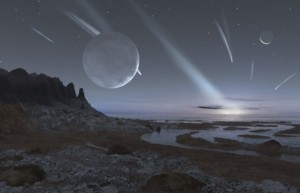
Searching for Life on Other Worlds
Are we alone or do we share our solar system and galaxy with other forms of life? And how widespread are advanced civilizations with whom we could communicate?
Robert Naeye
Sunday, July 11, 2021
7:30 PM to 9:00 PM EST
Online event
meet.google.com/osh-bcyd-gti
Monthly Meeting – Public Invited
Abstract:
Are we alone or do we share our solar system and galaxy with other forms of life? And how widespread are advanced civilizations with whom we could communicate?
Right now we don’t have answers to these profound questions. But scientists are in hot pursuit. The technology of searching for life on other worlds has reached a level of maturity where the first definitive evidence of extraterrestrial life could come in the very near future.
Science journalist Robert Naeye will explore three different roads for detecting life beyond Earth:
- Launching robotic spacecraft to discover life on Mars or other worlds in our solar system.
- Deploying large telescopes to detect the chemical signatures of life in the atmospheres of planets orbiting other stars.
- Using various techniques to pick up signals from advanced civilizations or to find evidence of their technological activities.
Robert’s talk will be loosely based on a cover story he wrote for the September 2020 issue of Astronomy magazine. His talk will be nontechnical and intended for a general audience.
Bio:
Robert Naeye is a freelance science journalist based in Hershey, Pennsylvania. He is a former editor in chief of Sky & Telescope, the world’s most respected popular astronomy magazine. He also worked for NASA at its Goddard Space Flight Center in Maryland. During his 30-year career he has written hundreds of articles about astronomy and space science. He has authored two books and contributed to three others. Please visit his website at www.robertnaeye.com.
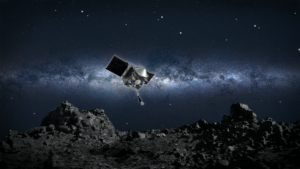
To Bennu and Back Again: the OSIRIS-REx Sample Return Mission
Are we alone or do we share our solar system and galaxy with other forms of life? And how widespread are advanced civilizations with whom we could communicate?
Dr. Hannah Kaplan
Sunday, August 8, 2021
7:30 PM to 9:00 PM EST
Online event
meet.google.com/osh-bcyd-gti
Monthly Meeting – Public Invited
Abstract:
On October 20, 2020, the OSIRIS-REx spacecraft successfully collected a sample from the surface of near-Earth asteroid (101955) Bennu. That sample will be delivered to Earth in 2023 for analysis in state-of-the-art laboratories. In the meantime, our best information on Bennu’s origin, geologic history, and composition comes from instruments on the spacecraft, which observed the asteroid for multiple years before sample collection. Important findings include the presence of water and organics on the surface, and contamination from other asteroids. Through the lens of the OSIRIS-REx spacecraft observations, Dr. Kaplan will describe Bennu’s history and implications for the returned sample.
Bio:
Dr. Kaplan is a research space scientist at Goddard Space Flight Center. She uses remote sensing observations to understand the composition of planetary surfaces, including asteroids and Mars. She is a member of the OSIRIS-REx science team and the Lucy L’Ralph instrument science team. Before coming to Goddard, Dr. Kaplan worked at Southwest Research Institute in Boulder, Colorado where she was a postdoctoral researcher working on OSIRIS-REx.

Astronomy with X-rays: How, Where, and Most Importantly Why?
Dr. Randall Smith
Sunday, September 12, 2021
7:30 PM to 9:00 PM EST
Online event
meet.google.com/osh-bcyd-gti
Monthly Meeting – Public Invited
Abstract:
X-ray astronomy began in 1962 when Riccardo Giacconi and his team launched a sounding rocket with an X-ray detector designed to look at the Moon – and unexpectedly found a far brighter source in Scorpius they called Sco X-1. Generating X-rays requires energetic processes – big explosions, strong gravitational fields, and collisions of fast or even relativistic particles. Observing them thus reveals just what’s going on in these exciting regions of space. We can also take advantage of the penetrative properties of X-rays – just as we do to look at a broken bone here on Earth – to study material between the source and us as the X-rays are absorbed and scattered by gas and dust. Since 1962 the field has exploded, with a range of new detectors as well as techniques to make high-quality X-ray “mirrors.” This talk will be a survey of the field, highlighting important discoveries as well as the instrumentation required, as well as discussing where we’re going next.
Bio:
An astrophysicist at the Harvard-Smithsonian Center for Astrophysics, Randall Smith primarily works in high-energy astrophysics. He is involved with multiple X-ray observatories, both current and planned; his personal research focuses on the interstellar medium and on maintaining an atomic database that is used throughout the field to model the spectra of hot collisional plasmas. He earned his PhD in 1997 at the University of Wisconsin-Madison, working with the Space Physics group and advisor, Dr. Don Cox.
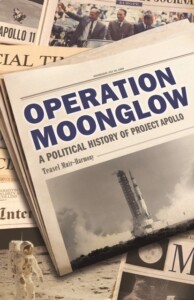
Operation Moonglow: A Political History of Project Apollo
Dr. Teasel Muir-Harmony, PhD
Sunday, October 10, 2021
7:30 PM to 9:00 PM EST
Online event
Monthly Meeting – Public Invited
Abstract:
On July 20th, 1969, over half the world’s population witnessed Neil Armstrong’s first step on the Moon. While often remembered as a scientific and technological feat, the ambitions of the Apollo program aimed far beyond the Moon. Through spaceflight, America sought to win hearts and minds, foster alliances, and shape the political trajectories of newly independent nations. Drawing on a rich array of untapped archives and firsthand interviews, Operation Moonglow knits together a story of politics and propaganda; diplomacy and spaceflight; decolonization and globalization to reveal the political forces that not only sent humans to the Moon but also attracted the largest audience in history.
Bio:
Dr. Teasel Muir-Harmony is the curator of the Apollo Collection at the Smithsonian National Air and Space Museum in Washington, DC. She earned a PhD from MIT and has held positions at the American Institute of Physics and the Adler Planetarium and Science Museum. She is the author of Operation Moonglow: A Political History of Project Apollo (2020) and Apollo to the Moon: A History in 50 Objects (2018), and a contributor to the television series Apollo’s Moon Shot. In addition, Muir-Harmony co-organizes the Space Policy & History Forum and teaches at Georgetown University.

Come Fly Away to the Sun
Dr. Kelly Korreck
Sunday, November 14, 2021
7:30 PM to 9:00 PM EST
Online event
Monthly Meeting – Public Invited
Abstract:
What is faster than a speeding bullet? What can fly through turbulence without fastening its seat belt? What can tell us about the origin of our solar system at same time performing its main mission to understand our closest star? NASA’s Parker Solar Probe!
The Parker Solar Probe (PSP) spacecraft was designed to aid in solving 3 mysteries of the Sun as well as the very practical goal of furthering the understanding of space weather. Space weather ranges from billions of tons of material hurled at Earth as Coronal Mass Ejections (CMEs) and solar flares that accelerate energetic particles that could damage electrical power grids on the Earth as well as harm astronauts in space. Parker has made measurements of a stealth or Streamer Blow Out Coronal Mass Ejections (SBO-CMEs) which create space weather. Learning to recognize and characterize these early CMEs help to understand their evolution through the solar system. In addition to studies of the Sun and solar wind, the mission has been able to study Venus, dust, and even capture photos of a comet! Come learn about the coolest hottest mission to the Sun!
Bio:
Astrophysicist Kelly Korreck knows how to handle the heat. She builds and operates instruments to study the Sun and understand its hot explosive outer atmosphere or corona. Her career has taken her from the desert of New Mexico to Japan, to the innermost part of the solar system. Kelly headed up science operations and project management for the SWEAP Suite aboard Parker Solar Probe. She works with engineers and scientists to create the best data from this once-in-a-lifetime mission. Kelly holds a Bachelor of Science degree in Physics and Astronomy and a Ph.D. in Space Physics both from the University of Michigan. When not studying the sun, she can be found near the beach, running, dancing, or in the yoga studio.
How to Optimize your Astrophotography Setup
Dr. Thomas B. Fowler
Sunday, December 12, 2021
7:30 PM to 9:00 PM EST
Online event
Monthly Meeting – Public Invited
Abstract:
Amateur astronomers know too well that using a $400 Tele Vue eyepiece with a $100 telescope would be a waste of money and the capabilities of the Tele Vue. It would work, but for $500 a much better optical train could be assembled. Similarly, any attempt to get 300x out of a 60mm f//10 telescope using a 4mm eyepiece and a 2x Barlow would be disappointing. A 25 lb. telescope on a flimsy mount might not collapse the mount, but it would not make for good viewing. These examples illustrate that in astronomy as elsewhere, for optimum performance and return on investment, it is necessary to use carefully matched equipment. In this talk Dr. Fowler will explain the issues involved in matching optical equipment, astronomy cameras, and mechanical gear to determine optimal performance and the limits to any given astrophotography configuration.
Bio:
Thomas B. Fowler has been involved in astronomy since 1960. He is the author of over one hundred articles, many reviews for Cloudy Nights, and three books, including a book on astronomy equipment and techniques, “The View Through Your Telescope and How to Make it Better” (2020). He has given presentations to the Northern Virginia Astronomy Club and the TriState Astronomers. He is an independent consultant on technology to the U.S. government and Adjunct Professor of Engineering at George Mason University. He has lectured widely on science, technology, and philosophy. His doctorate from George Washington University is in system theory. He also owns 3 telescopes and too much other astronomy equipment to think about! His books can be ordered from Amazon.
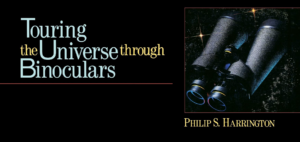
Two Eyes are Better than One
Philip S. Harrington, FRAS
Astronomy Author/Educator
Contributing editor, Astronomy magazine
Sunday, January 9, 2022
7:30 PM to 9:00 PM EST
Online event
Monthly Meeting – Public Invited
Abstract:
Binoculars are NOT just for beginners, as this talk will stress. After various binocular-related terms are defined, Phil Harrington will offer consumer tips to help the audience weed out astronomically worthy binoculars from a vast ocean of models currently available.
Bio:
A lifelong amateur astronomer, Phil Harrington was bitten by the “astronomical bug” when he was assigned to watch the total lunar eclipse of April 1968 as a homework assignment. Since then, Phil has spent countless hours touring the universe through telescopes and binoculars. He is a former staff member of New York City’s Hayden Planetarium and instructor at the Vanderbilt Planetarium in Centerport, New York. Phil is an adjunct professor at Suffolk County Community College, Selden, New York, where he teaches courses in stellar and planetary astronomy. He is a founding member of the Westport (CT) Astronomical Society and is also one of the coordinators of the annual Astronomer’s Conjunction, held every summer in Northfield, MA. Phil is also a contributing editor for Astronomy magazine, where he has published more than 200 articles since 1988.
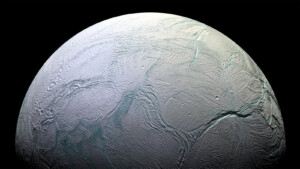
Wild and Wonderful Space Volcanoes!
Caitlin Ahrens, Ph.D.
Sunday, February 20, 2022
7:30 PM to 9:00 PM EST
Online event
Monthly Meeting – Public Invited
Abstract:
How are there many different types of volcanoes in our Solar System? How do these volcanoes form and evolve? We’ll explore the marvelous volcanic wonders of the Solar System by deep diving into how they behave and form from different planetary materials, including the mysteries of cryovolcanism!
Bio:
Caitlin Ahrens’ research involves remote sensing of icy surfaces and volatile interactions, including permanently shadowed craters at the lunar poles and cryovolcanism. Dr. Ahrens also works on several planetary geomorphology projects, including lava flow morphology, caldera formation, and rheology, on Mars, Ceres, Titan, and Pluto.
Dr. Ahrens received her B.S. in Physics/Astrophysics and Geology from West Virginia University in 2015, and a Ph.D. in Space and Planetary Science at the University of Arkansas in 2020. Dr. Ahrens is currently a NASA Postdoctoral Program Fellow at the Goddard Space Flight Center, and a member of the Diviner Science Team with the Lunar Reconnaissance Orbiter. In 2018, she was awarded the Ten Outstanding Young Americans award by the Jaycees for her efforts in science communication and outreach.
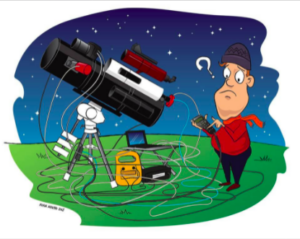
Improving the Performance of Your Imaging Mount
Eric Snow, Ph.D.
Sunday, March 13, 2022
7:30 PM to 9:00 PM EST
Online event
Monthly Meeting – Public Invited
Abstract:
In this presentation, Eric will share his experience on improving the performance of equatorial mounts, a critical and expensive component of astrophotography systems. He will start with the basics of operation and cover the common sources of tracking errors found in lower- to moderately-priced systems. Eric will then present a strategy to minimize these errors by using “hypertuning” and optimized guiding. The presentation will serve as a “How-To” guide for achieving atmospheric-seeing-limited imaging performance with less expensive mounts.
Bio:
Dr. Eric Snow recently retired from a 35-year scientific career at the Naval Research Laboratory where he served as the Director of the Institute for Nanoscience and as Head of the Physics of Electronic Materials Branch. Eric’s field of expertise is Nanoscience, which is the study and engineering of matter at the nanometer length scale. In retirement Eric has changed course and is learning about the universe at the opposite end of the length scale, the scale of light-years. In this pursuit Eric joined NOVAC and has taken up the hobby of astrophotography.

